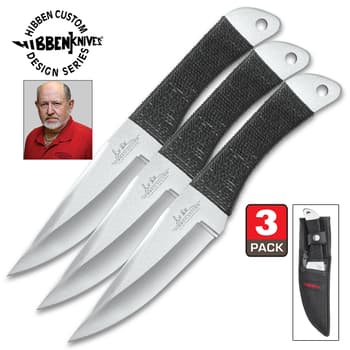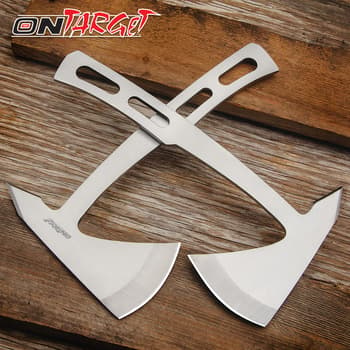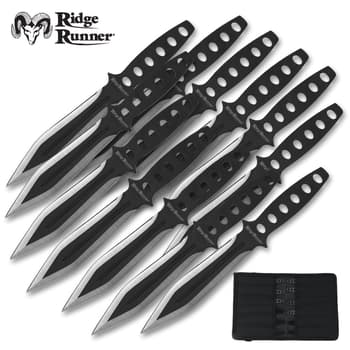Best Throwing Knives: Beginners to Pros Can Benefit

By Adelia Ladson
Why You Should Learn the Art of Throwing
Knife throwing is an age-old pastime both as recreation and as friendly competition that has brought hours of fun to friends and families. It has become a worldwide sport with associations that sponsor competitions and exhibitions. These events allow knife throwers to get together and exchange information and spectators to be entertained in an atmosphere, which stays true to its roots of friendly fellowship.
Basic Types of Throwing Knives
A throwing knife comes in many different sizes, profiles and materials. However, two things remain constant: the blade has a point that will penetrate a target and the knife is sturdy so that it can take the impact.
There are three different kinds of knives which are most commonly thrown, blade-heavy, handle-heavy and balanced. The important thing is making sure that distribution of weight is used to decide which way to grip the knife. The weight must always be thrown first. When throwing a blade-heavy knife, grasp it by the handle so that the heaviest part of the knife, the blade, is directed at the target. When throwing a handle-heavy knife, carefully grasp the knife by the blade so that the handle is directed at the target. A balanced knife, which is usually best for a beginner, can be gripped by either the handle or the blade. It’s not necessary for a throwing knife to have sharp edges since it’s the point that needs to penetrate the target.
| Balanced Knife – Beginners | |
|---|---|
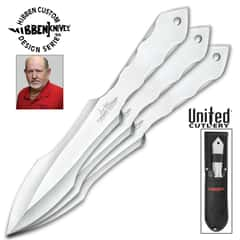 Gil Hibben Champion Throwing Knife Set |
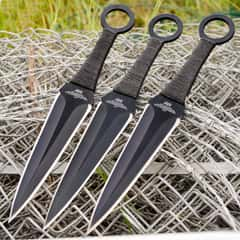 Expendables Kunai Set |
Blade Heavy – Beginners and Experienced |
 Super Spartan Throwing Dagger |
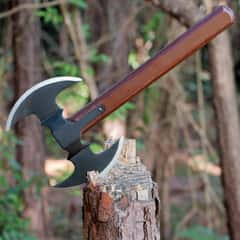 Double-Bladed Throwing Axe |
Handle Heavy – Experienced |
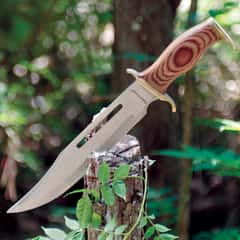 Timber Rattler Jungle Fury Bowie Knife |
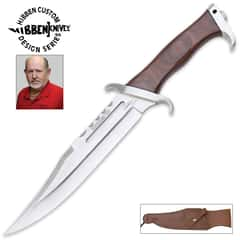 Gil Hibben Fighter Knife |
| Balanced Knife – Beginners | |
|---|---|
 Gil Hibben Champion Throwing Knife Set |
 Expendables Kunai Set |
Blade Heavy – Beginners and Experienced |
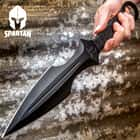 Super Spartan Throwing Dagger |
 Double-Bladed Throwing Axe |
Handle Heavy – Experienced |
 Timber Rattler Jungle Fury Bowie Knife |
 Gil Hibben Fighter Knife |
How to Throw a Knife
The concept of knife throwing is pretty simple. A bladed object is thrown at a target with the goal of it sticking into the target and throws can be scored, for accuracy, on a bull’s eye for competition and fun. Simple, right? Well, "the devil is in the details," so here are the basic physics of knife throwing.
Once thrown a knife either spins end-over-end in the air toward its target, which is most common, or it doesn’t spin at all and flies tip first at the target. The way it travels through the air to the target relies on the technique the knife-thrower employs when it leaves his hand. The speed at which the knife spins through the air around its center of gravity is connected to whether the thrower’s arm is kept bent or extended during the throw. The more extended the arm, toward the target, the slower the knife’s rotation in the air. Controlling the speed of the spin lets the thrower control over-spin or under-spin when the knife reaches the target. The importance of this is that this is a factor that can be adjusted to make sure the knife hits the target blade first instead of handle first. One of the most important variables a beginner needs to focus on is distance because there is a "sweet spot" for each individual where the knife reaches the target tip first. Even adjusting a few steps toward or away from the target can make a difference.
The first thing to learn is how to grip the knife that is going to be thrown. There are two basic ways to grip a throwing knife – the hammer grip and the pinch grip. And then, there are different variations on the two ways. In the end, what it comes down to is what is most comfortable and successful for each individual. The Hammer Grip, just like its name says, is where the knife is held like one holds the handle of a hammer. The fingers are wrapped around the handle of the throwing knife and the thumb can be placed on the spine of the blade or not. When throwing lightweight knives, which have a piercing point but no sharpened edges, the Pinch Grip is the easiest method to use. Grip either the handle or the blade between the thumb and index finger in a secure pinch. The grip can be held with only the fingertips or closer to the hand and, if the thrower is a little heavier, add the middle finger for stabilization.
Once a comfortable grip on the throwing knife is achieved, take a throwing stance. One foot will be positioned in front of the other one with a comfortable width and length between them for a balanced and steady feel, keeping the heels in line with one another. The stance will be like a normal walking step is being taken. When the knife is thrown, weight will be shifted to the front foot with the forward movement of the chest and throwing arm. Make sure chest, hips and feet are facing the target. The foot that is in front should be the one opposite from the hand used to throw the knife.
When ready to throw the knife, extend the throwing arm out in a straight line to the target, then, bring the throwing arm up to a 90-degree angle, bending from the elbow, toward the chest. Make sure the knife stays extended in a straight line from the hand. Now, draw the arm up and back so that the knife goes alongside the head at about the level of the ear. The arm is swung rapidly forward and extended from the elbow in a downward motion. It is important to continue the swing even after the knife has been released.
"Timing is everything," aptly describes the release of the knife during the throw. When it’s released at the right moment, the knife will stick perfectly into the target horizontally. The grip, stance and throwing motion can be perfect but if the release isn’t smooth and timely, the chances of the knife hitting the target are slim. The knife is released just before the knife is pointing dead at the target. Some experts say the knife should be released when it is pointing straight up in the air and others say it should be released as the throwing arm just starts its downward swing. What it boils down to, though, is what works best for the individual and this can only be determined through trial and error.
The most important thing to remember about taking up throwing knives for hobby or sport is to not get frustrated because "practice makes perfect". Make the decision now that you are going to learn from each throw so that you can get better. To learn more about knife throwing check out our Knife Throwing Guide edited by the 4-time world champion knife thrower Adam Celadin.
Related Products






















